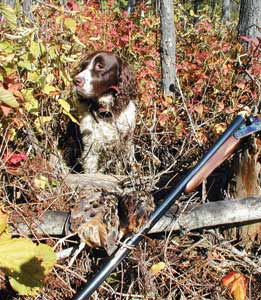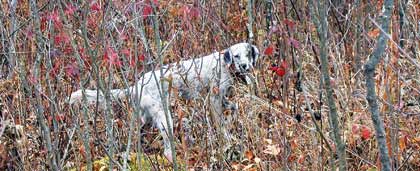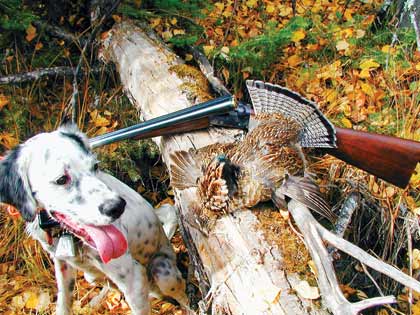Making the switch from flushing dogs to pointing dogs.
By Cliff Bentley
 Flushing dogs are just as productive as pointing dogs. Snoopy, the author's springer, with a pair of woodcock. |
The chocolate chip cookies convinced me. More accurately, the person making the cookies convinced me. After years of hunting with springer spaniels, I had decided to buy a Llewellin setter and I was contacting prospective breeders.
Twin Cedars Kennels in Wingo, Kentucky, owned by Randy Johnson, was the fourth one I called. I never made it to the fifth. Kena Johnson answered the phone while making cookies for her son Jeremy. We chatted for about half an hour, mostly about life in general and only a little about dogs.
I was sold before even talking to Randy because of the pleasant conversation I had with Kena and I decided to get my new puppy from the Johnsons out of a breeding that had produced excellent pups in the past. This was my most important step in making the switch from flushing dogs to pointing dogs. A well-bred dog is born with the skills to do its job, making training much easier. We named our pup "Aspen."
Why Make The Switch?
I had started hunting birds with no dog at all, precisely because I was a kid and had no say in the matter of owning a dog. When I did hunt with a dog, it was with friends or family who owned flushing dogs and were kind enough to let me tag along. If you've ever hunted with a flushing dog you don't need me to tell you they're every bit the bird-finder a pointing dog is, so why make the switch? The reasons vary.
I once asked some pointing dog enthusiasts why they chose pointing dogs. One of the more interesting replies was, "Well, I hunt birds. What else would I use but a bird dog?" I don't believe the response was intended to be condescending or sarcastic as much as a statement of the obvious. It had simply never occurred to him that it was possible to use a flushing or retrieving breed for upland bird hunting. I knew better, but it increased my curiosity about pointing dogs.
My good friend and hunting partner, Mike Minar of New Prague, Minnesota, has a Lab named Jake, but Mike is considering a pointing breed for his next dog because, as he says, "I'm getting older and it's harder for me to keep up with a flushing dog." I can relate. I once came back from a pheasant hunting trip in South Dakota with a bad case of runner's knee from following my springer spaniel across the prairie after running pheasants.
Mark Cyccone from Michigan, started the same way I did, initially hunting without a dog before getting a springer spaniel. He was very happy with his springer, Kelly, so I asked him why he got a Brittany instead of another springer when Kelly passed away. His decision began when he was invited by a friend at work to hunt with a man who owned a Brittany named Ginger.
"The first bird Ginger pointed was a hen pheasant directly in front of me," said Mark. "Don told me to walk past her point and flush the bird, but I could hardly take my eyes off the dog. I was sure glad it was a hen because I would never have gotten the gun up anyway. I was mesmerized by Ginger's point.
"I just had to have a pointing dog and purchased my first Brittany pup shortly afterwards. I really enjoyed hunting with the flusher, but for me there is something mysterious, magical and beautiful when a dog goes on point. I guess that's the main reason I made the switch."
 The thrill of a dog on point. Aspen pointing a woodcock during her first season. |
Me? I can't tell you exactly why I switched, but I probably shared some of the same feelings Mike and Mark expressed€¦although without the epiphany Mark experienced. In the end I guess it was just something I really wanted to try — a romantic notion that had to be satisfied.
If you're considering switching, maybe you're like Mike, with a straightforward, logical reason. Maybe you're like Mark and you want to have more of something enjoyable you've discovered, or maybe you just want to try something new.
Training Differences
I have no intention of explaining how to train a pointing dog. I could tell you, but it would only be repeating things I've learned from folks who know a lot more than I do about dog training. Better for you to talk to people like them yourself, or read any of the excellent training books available. Training techniques aren't what this article is about, anyway.
Instead, I'll share my observation that training a pointing dog appears more complicated than it really is. It might seem like more than you can handle, like it did to me, but just like riding a bike or falling in love seems impossible until you do it, it's not as complicated as it seems. The subtleties of finishing a pointing dog can be time consuming, but I found if you just want a hunting partner, it's not much different than training your flushing dog.
The only significant difference I've noticed is that you train the flusher to stay within gun range and you encourage the pointer to range away from you in search of birds. That's it — the big training difference. There are many different techniques, of course, but those are details.
A few years back, while "window shopping" for a pointing dog, I visited a man who had a litter of English setter pups for sale. While my daughter was sitting on the ground under a swarming ball of puppies, I asked about teaching them to point. "Ah, you don't," he said. "They just do it. They can't help it. All you got to do is teach them to stay that way until you flush the bird." I suspected him of downplaying the complexity of training a pointing dog to make a sale, but it turns out he wasn't too far off.
Professional dog trainer Greg Fryar, owner of High Fly'n Kennels in Elko, Minnesota, feels that it's important in training both types of dog to expose them to birds and get them into the field early, before obedience drilling too much, to inspire their prey drive. He feels there isn't a fundamental difference in training methods for the two types of dog, and that the biggest mistake amateur trainers make is to rush things.
About specific differences in training techniques, he says, "There aren't any real differences. I use the same techniques with all breeds. I just teach the retrievers to sit and the pointing breeds to stand. Otherwise, I treat them all the same."
During Aspen's first season, I occasionally turned to Randy Johnson for training advice and guidance from somebody who actually knew what he was doing. The best, most helpful advice he gave me was to treat the first season as a "bank account."
Randy said, "All of the positive experiences are deposits and the disciplinary actions you use to get your dog under control are withdrawals. You have to make deposits before you can make withdrawals. The more deposits you make, the less the withdrawals affect you."
 Good things happen when the bell stops...well, sometimes, anyway. |
The key to this approach is to have a well-bred dog with good instincts. That's why my conversation with Kena about cookies was the best "training" I ever did with Aspen.
What to Expect
After you've made the switch from a flushing dog to one that stops when it finds a bird, you don't know what to expect. You're excited but a little uneasy. Hundreds of questions will run through your head the night before your first hunt, causing you to sleep like a colicky baby, or a kid on Christmas Eve. Maybe knowing what it can be like will make it easier for you than it was for me.
Years of hunting with flushing dogs had conditioned me to keeping the dog within gun range. If the dog got too far out, I called it back. If it followed a running bird, I tried my best to keep up. Knowing that a pointing dog's job is to cover as much ground as possible in search of birds, I tried to keep my mouth shut as Aspen roared through the brush like something bad was after her.
I knew that trying to keep a pointing dog close defeated the purpose of having one, but that didn't make it any easier. Whenever I couldn't see Aspen I became anxious. But then her bell would stop. I'd hurry to her point, trying to concentrate despite the adrenaline-fueled roar in my ears, feeling the same way Mark did with Ginger. Having it work the way it was supposed to helped me slowly become comfortable with not always knowing where Aspen was.
A revelation occurred the first time we hunted in snow when, everywhere I walked, there were dog tracks already there. I realized if there were birds around, she would find them. That's when I finally evolved from a flushing-dog man hunting with a pointing dog to a real pointing-dog man. A pointing-dog man relaxes, trusts the dog and lets it produce the birds. You have to be comfortable with occasionally not knowing where your dog is.
Another difference is the variation in shots offered by the two types of dogs. Since a bird flushed by a dog is trying to escape the dog, not the shooter, the bird can fly at any angle and can appear at any moment. Sometimes they'll fly directly at you. I once accidentally evaporated a woodcock flushed by my father's springer when it came at me like a skeet target from low-house eight.
With a pointing dog, I don't expect that angle of shot very often anymore. The thing I have to get used to now is not knowing exactly where the bird is when Aspen is on point. In good scenting conditions, a dog can point a bird from 40 yards away, or more. You may have to look around a bit before the bird flushes, or even release the dog to relocate a bird that has run out from under the point.
I once missed an opportunity for an easy shot because I didn't spend enough time attempting to flush. I assumed the bird had run off, released Aspen from point, and watched with my gun down and my mouth open as a grouse flushed from behind the small cedar tree next to us. Aspen knew better — she hadn't moved.
Summary
In the end, the biggest adjustment will be accepting that your pointing dog will often be far away. There are many other smaller differences, of course, but those are just nuances. A pointing dog will hunt farther from you than a flushing dog will, and that's as it should be.
If you're not comfortable with your dog hunting beyond gun range, you should do yourself a favor and stick with a flushing dog. You'll both be happier. Neither type of dog is really "better" than the other, but if you'd like to try a dog whose bell stops when it finds a bird, don't miss out by assuming the requirements will be too difficult to master.






